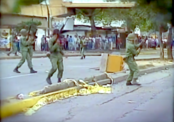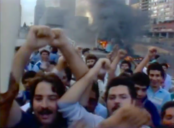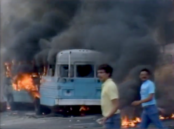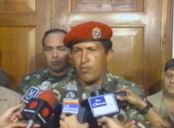User:Mu/Sandbox5
This article is incomplete because it is pending further input from participants, or it is a work-in-progress by one author. Please comment on this article's talk page to share your input, comments and questions. Note: To contribute to this article, you may need to seek help from the author(s) of this page. |
| Marigold Revolution Revolución De Marigold | |||||||
|---|---|---|---|---|---|---|---|
| Part of the Marchenian transition to democracy | |||||||
Top to bottom, left to right: UOFLA combatants seizing the Red House, Marchenian Army soldiers attempt crowd control in Gualencia, pro-coup civilians riot in Buenadora, a bus burns during riots in Gualencia, Maximiliano Fraga announces the success of the coup, Javier García announces the end of La Dictablanda. | |||||||
| |||||||
| Belligerents | |||||||
| Commanders and leaders | |||||||
|
Pres. Alfredo Andrade Vice Pres. Nico Gallo Gen. Macos de la Cruz † Adm. Leonardo Ocampo ACM. Gonzalo L'Agnese |
Colonel Maximiliano Fraga RAdm. Angel Mina W/C Joshua Bienvenida | ||||||
| Political support | |||||||
|
Party of Republican Institutions Conservative Party |
Movement for Democracy Popular Resistance Civilians | ||||||
| Casualties and losses | |||||||
|
45-100 killed and 125-250 injured Unknown number of civilians killed or injured during the coup and subsequent unrest | |||||||
The Marigold Revolution (Marchenian: Revolución de Marigold), also known as the April Fool's Coup (Marchenian: Golpe de Día de los Inocentes ) or misnomerically as the Seven Days of April (Marchenian: los Siete Dias de Abril) was initially a military coup on the 1st of April, 1989 in Gualencia and other major cities which overthrew the government of Conservative president Alfredo Andrade and the authoritarian civic-military dictatorship that had led the country since the 1938 coup which ended democracy in Marchenia. The coup was organized by a group of officers throughout the Marchenian Armed Forces, styling themselves as the Union of Free Officers of the Armed Forces, who had grown disenchanted with the existing governing system. The coup was only partially successful, though it created enough chaos and disorder within the country to allow for a popular protest campaign to emerge. The revolution led to the end of La Dictablanda, the termination of Operation Raptor, and the marked the beginning of the Marchenian transition to democracy. Following the end of the civic-military dictatorship presidential powers were assumed by the lawyer and technocrat Javier García. García, a political independent, would serve as president until free elections were held the following year.
The name emerged following the Revolution, being named as such due to the marigold flowers offered by civilians to soldiers who defected to the side of the Free Officers at various points during the unrest. In Marchenia the period from 30 March to the 14 April is regarded as a period of remembrance, with the 14 April being recognized as a national holiday.
Overview
History
La Dictablanda
Economic issues
Operation Raptor
Political repression
Events of the Revolution
March 30
- Members of the UOFLA, masquerading as members of the Marchenian resistance, detonate a series of bomb attacks within the capital Gualencia, as well as the cities of Andasca, Buenadora, and Pohuela.
- A state of emergency is declared within the capital, allowing UOFLA loyalist units to move about major cities freely.
- The Marchenian Army is deployed to major government sites.
March 31
- Members of the UOFLA, masquerading as members of the Marchenian resistance, assassinate General Macos de la Cruz, de-facto Commander in chief of the Marchenian Armed Forces at his home in Gualencia.
- Important members of the civic-military dictatorship are placed under protective custody of military units, many of whom are secretly loyal to the UOFLA.
- UOFLA loyalists relieve members of the Army at many government sites, taking up strategic positions throughout the country.
- UOFLA contacts members of the Movement for Democracy as well as various Popular Resistance units and inform them to prepare for "certain events" in the coming hours.
April 1
- Telephone lines are cut within the capital and other major cities.
- UOFLA loyalists storm La Casa Roja, arresting President Alfredo Andrade and placing him under house arrest. Vice President Nico Gallo is also captured and arrested.
- Most important members of the civic-military dictatorship are detained
- UOFLA loyalists seize television and radio stations, announcing "a temporary state of exception" within the country due to "hostile forces."
- Marchenian government loyalist units begin engaging in combat with UOFLA combatants within the capital.
April 2
- Important members of the civic-military dictatorship continue to be detained.
- Popular Resistance and Movement for Democracy agents in major cities begin protests.
- Military and police response to the protests are sporadic, with many units unsure of how to respond due to a lack of orders from command.
- Sporadic fighting between loyalists and putschists continues nationwide
April 3
- The UOFLA declares that they have seized control of the country, announce the intention to begin a transition to a new government "once the national civil disturbances have subsided."
- Government loyalists assemble in the city of Comisillo, a government stronghold, and decry the events as "an illegal coup."
- Sporadic fighting continues
- Protests in many contested cities devolve into riots
April 4
- Various members of the civic-military dictatorship announce support for the coup
- The UOFLA, the Movement for Democracy, and the Popular Resistance announce the creation of the Marchenian Transitional Governing Authority; loyalists deny its legitimacy.
- Riots continue, with many cities becoming practically ungovernable.
- Some members of Parliament, as well as civic-military dictatorship officials, open negotiations with the UOFLA.
April 5
- Most units of the military not forcibly disarmed defect to the UOFLA.
- President Andrade and Vice President Gallo tender their resignations.
April 6
- The MTGA announces that Javier García will assume presidential authority over the country and armed forces.
- Putschists enter the Comisillo without resistance.
April 7
- García is sworn in as President during a joint-session of Parliament
- At his swearing-in speech García announces the end of the civic-military dictatorship, the end to both the national state of emergency and state of exception within the country, the allowance of political parties outside of El Pacto de Trastienda, and the date for fresh elections "within one year."
- Most military units return to their barracks.
Aftermath
Domestic Reaction
Political parties
Domestic resistance groups
International Reaction
- File:ImaguaFlag.png Imagua and the Assimas - Prime Minister Edmondo Privitera said that "Imagua recognises the new government as legitimate, and looks forward to maintaining our close ties."
 Satavia - Prime Minister Richard Bingham confirmed Satavian support for the revolution saying "Satavia will recognise the new Marchenian Government and will encourage others to do so, as democracy has once again been restored to Marchenia".
Satavia - Prime Minister Richard Bingham confirmed Satavian support for the revolution saying "Satavia will recognise the new Marchenian Government and will encourage others to do so, as democracy has once again been restored to Marchenia". Belmonte - Ever since the 80s, Belmonte pressed against the continuation of military regimes in the Asterias. Once news of the revolution reached Castelonovo, Premier Félix Bragança reacted positively, declaring that the Marchenian people "finally rejoiced after decades of unfair authoritarian rule." The government immediately recognized the new regime.
Belmonte - Ever since the 80s, Belmonte pressed against the continuation of military regimes in the Asterias. Once news of the revolution reached Castelonovo, Premier Félix Bragança reacted positively, declaring that the Marchenian people "finally rejoiced after decades of unfair authoritarian rule." The government immediately recognized the new regime.





